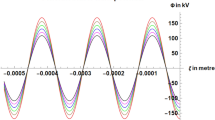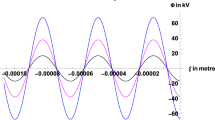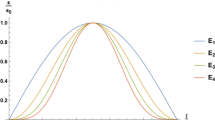Abstract
The phenomenon of laser wakefield acceleration is one of the prominent mechanisms to accelerate electrons to very high energies within a very small propagation distance. In this study, we have chosen Sinh–Gaussian laser pulse with static magnetic field perpendicular to direction of propagation of pulse. Analytical solution for chosen electric field is obtained from a generalized differential equation of laser wake potential. Hence, expressions for wakefield and electron energy gain are also obtained. Using feasible parameters, it is observed that when laser field amplitude increases from \(3.85 \times 10^{11} \) to \(4.81 \times 10^{11} \;{\text{V}}/{\text{m}}\), electron energy gain increases from 102.504 to 160.163 MeV in the absence of external magnetic field and 103.258 to 160.918 MeV in an external magnetic field of 40 T. So, laser field amplitude and strength of magnetic field both have direct impact on electron energy gain and enhance in energy gain can be seen. Our research will be useful for the researchers to obtain a more energy efficient electron acceleration mechanism.






Similar content being viewed by others
Data availability
The data that support the findings of this study are available from the corresponding authors upon reasonable request.
References
M. Singh, R.K. Singh, R.P. Sharma, THz generation by cosh-Gaussian lasers in a rippled density plasma. EPL (Europhys. Lett.) 104(3), 35002 (2013)
H.K. Midha, V. Sharma, N. Kant, V. Thakur, Efficient THz generation by Hermite-cosh-Gaussian lasers in plasma with slanting density modulation. J. Opt. (2023). https://doi.org/10.1007/s12596-023-01413-5
H.K. Midha, V. Sharma, N. Kant, V. Thakur, Resonant Terahertz radiation by p-polarised chirped laser in hot plasma with slanting density modulation. J. Opt. (2023). https://doi.org/10.1007/s12596-023-01563-6
V. Thakur, N. Kant, S. Kumar, THz field enhancement under the influence of cross-focused laser beams in the m-CNTs. Trends Sci. 20(6), 5284 (2023)
S. Kumar, S. Vij, N. Kant, V. Thakur, Combined effect of transverse electric and magnetic fields on THz generation by beating of two amplitude-modulated laser beams in the collisional plasma. J. Astrophys. Astron. 43(1), 30 (2022)
S. Kumar, S. Vij, N. Kant, V. Thakur, (2022) Interaction of obliquely incident lasers with anharmonic CNTs acting as dipole antenna to generate resonant THz radiation. Waves Random Complex Med. (2022). https://doi.org/10.1080/17455030.2022.2155330
S. Kumar, S. Vij, N. Kant, V. Thakur, Resonant terahertz generation by the interaction of laser beams with magnetized Anharmonic carbon nanotube array. Plasmonics 17(1), 381–388 (2022)
S. Kumar, S. Vij, N. Kant, V. Thakur, Resonant terahertz generation by cross-focusing of Gaussian laser beams in the array of vertically aligned anharmonic and magnetized CNTs. Opt. Commun. 513, 128112 (2022)
S. Kumar, V. Thakur, N. Kant, Magnetically enhanced THz generation by self-focusing laser in VA-MCNTs. Phys. Scr. 98(8), 085506 (2023)
S. Kumar, N. Kant, V. Thakur, Magnetically tuned THz radiation through the HA-HA-CNTs under the effect of a transverse electric field. Indian J. Phys. (2023). https://doi.org/10.1007/s12648-023-02849-y
M. Singh, D.N. Gupta, Relativistic third-harmonic generation of a laser in a self-sustained magnetized plasma channel. IEEE J. Quantum Electron. 50(6), 491–496 (2014)
V. Sharma, V. Thakur, A. Singh, N. Kant, Third harmonic generation of a relativistic self-focusing laser in plasma under exponential density ramp. Z. Naturfr. Sect. J. Phys. Sci. 77(4), 323–328 (2022)
S. Sohrabi, S. Jelvani, K. Samavati, L. Farhang Matin, Effect of chirp parameter on the second harmonic efficiency in relativistic super-Gaussian laser-plasma interaction. Opt. Quantum Electron 55(11), 942 (2023)
H.K. Dua, N. Kant, V. Thakur, Second harmonic generation induced by a surface plasma wave on a metallic surface in the presence of a wiggler magnetic field. Braz. J. Phys. 52(2), 44 (2022)
N. Kant, A. Singh, V. Thakur, Second-harmonic generation by a chirped laser pulse with the exponential density ramp profile in the presence of a planar magnetostatic wiggler. Laser Part. Beams 37(4), 442–447 (2019)
V. Thakur, N. Kant, Optimization of wiggler wave number for density transition based second harmonic generation in laser plasma interaction. Optik (Stuttg) 142, 455–462 (2017)
V. Thakur, N. Kant, Resonant second harmonic generation in plasma under exponential density ramp profile. Optik (Stuttg) 168, 159–164 (2018)
N. Gupta, S. Kumar, S.B. Bhardwaj, Stimulated Raman scattering of self-focused elliptical q-Gaussian laser beam in plasma with axial density ramp: effect of ponderomotive force. J. Opt. 51(4), 819–833 (2022)
S. Kumar, N. Kant, V. Thakur, THz generation by self-focused Gaussian laser beam in the array of anharmonic VA-CNTs. Opt Quantum Electron 55(3), 281 (2023)
V. Thakur, S. Kumar, N. Kant, Self-focusing of a Bessel-Gaussian laser beam in plasma under density transition. J. Nonlinear Opt. Phys. Mater. (2022). https://doi.org/10.1142/S0218863523500388
V. Thakur, N. Kant, Stronger self-focusing of cosh-Gaussian laser beam under exponential density ramp in plasma with linear absorption. Optik (Stuttg) 183, 912–917 (2019)
V. Thakur, M. Ahmad Wani, N. Kant, Relativistic self-focusing of Hermite-cosine-Gaussian laser beam in collisionless plasma with exponential density transition. Commun. Theor. Phys. 71(6), 736–740 (2019)
V. Thakur, N. Kant, Combined effect of chirp and exponential density ramp on relativistic self-focusing of Hermite-Cosine-Gaussian laser in Collisionless cold quantum plasma. Braz. J. Phys. 49(1), 113–118 (2019)
T. Tajima, J.M. Dawson, Laser electron accelerator. Phys. Rev. Lett. 43, 267 (1979)
T. Tajima, X.Q. Yan, T. Ebisuzaki, Wakefield acceleration. Rev. Mod. Plasma. Phys. 4(1), 7 (2020)
V. Sharma, V. Thakur, Enhanced laser wakefield acceleration utilizing Hermite-Gaussian laser pulses in homogeneous plasma. J. Opt. (2023). https://doi.org/10.1007/s12596-023-01565-4
V. Sharma, N. Kant, V. Thakur, Electron acceleration in collisionless plasma: comparative analysis of laser wakefield acceleration using Gaussian and cosh-squared-Gaussian laser pulses. J. Opt. (2024). https://doi.org/10.1007/s12596-023-01564-5
S. Afhami, E. Eslami, Effect of nonlinear chirped Gaussian laser pulse on plasma wake field generation. AIP Adv. (2014). https://doi.org/10.1063/1.4894452
H. Akou, M. Asri, Dependence of plasma wake wave amplitude on the shape of Gaussian chirped laser pulse propagating in a plasma channel. Phys. Lett. A 380(20), 1729–1734 (2016)
H.R. Askari, A. Shahidani, Effect of magnetic field on production of wake field in laser–plasma interactions: Gaussian-like (GL) and rectangular–triangular (RT) pulses. Opt. Int. J. Light Electron Opt. 124(17), 3154–3161 (2013)
M. Abedi-Varaki, N. Kant, Magnetic field-assisted wakefield generation and electron acceleration by Gaussian and super-Gaussian laser pulses in plasma. Mod. Phys. Lett. B 36(07), 2150604 (2022)
V. Sharma, N. Kant, V. Thakur, Effect of different Gaussian-like laser profiles on electron energy gain in laser wakefield acceleration. Opt. Quantum Electron 56(1), 45 (2024)
H.S. Ghotra, Laser wakefield and direct laser acceleration of electron by chirped laser pulses. Optik (Stuttg) (2022). https://doi.org/10.1016/j.ijleo.2022.169080
V.B. Pathak, J. Vieira, R.A. Fonseca, L.O. Silva, Effect of the frequency chirp on laser wakefield acceleration. New J. Phys. 14(2), 023057 (2012)
X. Zhang et al., Effect of pulse profile and chirp on a laser wakefield generation. Phys. Plasmas (2012). https://doi.org/10.1063/1.4714610
V. Sharma, S. Kumar, N. Kant, V. Thakur, Effect of frequency chirp and pulse length on laser wakefield excitation in under-dense plasma. Braz. J. Phys. 53(6), 157 (2023)
V. Sharma, S. Kumar, To study the effect of laser frequency-chirp on trapped electrons in laser wakefield acceleration. J. Phys. Conf. Ser. 2267(1), 012097 (2022)
A. Jain, D.N. Gupta, Optimization of electron bunch quality using a chirped laser pulse in laser wakefield acceleration. Phys. Rev. Accel. Beams 24(11), 111302 (2021)
S. Singh, D. Mishra, B. Kumar, P. Jha, Electron acceleration by wakefield generated by the propagation of chirped laser pulse in plasma. Phys. Scr. 98(7), 075504 (2023)
Y. Heydarzadeh, H. Akou, Effect of laser polarization mode on wake wave excitation in magnetized plasma. IEEE Trans. Plasma Sci. 48(9), 3088–3097 (2020)
V. Sharma, S. Kumar, N. Kant, V. Thakur, Enhanced laser wakefield acceleration by a circularly polarized laser pulse in obliquely magnetized under-dense plasma. Opt. Quantum Electron 55(13), 1150 (2023)
X. Zhang, T. Wang, V.N. Khudik, A.C. Bernstein, M.C. Downer, G. Shvets, Effects of laser polarization and wavelength on hybrid laser wakefield and direct acceleration. Plasma Phys. Control Fusion 60(10), 105002 (2018)
V. Sharma, V. Thakur, Lasers wakefield acceleration in underdense plasma with ripple plasma density profile. J. Opt. (2023). https://doi.org/10.1007/s12596-023-01548-5
A. Pukhov, I. Kostyukov, Control of laser-wakefield acceleration by the plasma-density profile. Phys. Rev. E 77(2), 025401 (2008)
D.N. Gupta, K. Gopal, I.H. Nam, V.V. Kulagin, H. Suk, Laser wakefield acceleration of electrons from a density-modulated plasma. Laser Part. Beams 32(3), 449–454 (2014)
C. Aniculaesei et al., Electron energy increase in a laser wakefield accelerator using up-ramp plasma density profiles. Sci. Rep. 9(1), 11249 (2019)
W.P. Leemans et al., Electron-yield enhancement in a laser-wakefield accelerator driven by asymmetric laser pulses. Phys. Rev. Lett. 89(17), 174802 (2002)
V. Sharma, S. Kumar, N. Kant, V. Thakur, Excitation of the Laser wakefield by asymmetric chirped laser pulse in under dense plasma. J. Opt. (2023). https://doi.org/10.1007/s12596-023-01326-3
B.-S. Xie, A. Aimidula, J.-S. Niu, J. Liu, M.Y. Yu, Electron acceleration in the wakefield of asymmetric laser pulses. Laser Part. Beams 27(1), 27–32 (2009)
K. Gopal, D.N. Gupta, Optimization and control of electron beams from laser wakefield accelerations using asymmetric laser pulses. Phys. Plasmas (2017). https://doi.org/10.1063/1.5001849
V. Sharma, S. Kumar, N. Kant, V. Thakur, Effect of wiggler magnetic field on wakefield excitation and electron energy gain in laser wakefield acceleration. Z. Naturfr. A (2023). https://doi.org/10.1515/zna-2023-0238
M. Abedi-Varaki, Electron acceleration by a circularly polarized electromagnetic wave publishing in plasma with a periodic magnetic field and an axial guide magnetic field. Mod. Phys. Lett. B 32(20), 1850225 (2018)
K.P. Singh, V.L. Gupta, L. Bhasin, V.K. Tripathi, Electron acceleration by a plasma wave in a sheared magnetic field. Phys. Plasmas 10(5), 1493–1499 (2003)
V. Sharma, S. Kumar, N. Kant, V. Thakur, Enhanced laser wakefield by beating of two co-propagating Gaussian laser pulses. J. Opt. (2023). https://doi.org/10.1007/s12596-023-01250-6
N.H. Mohammed, N.E. Cho, E.A. Adegani, T. Bulboaca, Geometric properties of normalized imaginary error function. Stud. Univ. Babes-Bolyai Mat. 67(2), 455–462 (2022)
H.R. Askari, A. Shahidani, Influence of properties of the Gaussian laser pulse and magnetic field on the electron acceleration in laser–plasma interactions. Opt. Laser Technol. 45, 613–619 (2013)
Funding
Not applicable.
Author information
Authors and Affiliations
Contributions
VS involved in derivation, methodology, analytical modeling, graph plotting, and result discussion; VT involved in supervision, reviewing, and editing.
Corresponding author
Ethics declarations
Conflict of interest
The authors declare no competing interest.
Ethics approval
Not applicable.
Consent to participate
Not applicable.
Consent for publication
Not applicable.
Additional information
Publisher's Note
Springer Nature remains neutral with regard to jurisdictional claims in published maps and institutional affiliations.
Rights and permissions
Springer Nature or its licensor (e.g. a society or other partner) holds exclusive rights to this article under a publishing agreement with the author(s) or other rightsholder(s); author self-archiving of the accepted manuscript version of this article is solely governed by the terms of such publishing agreement and applicable law.
About this article
Cite this article
Sharma, V., Thakur, V. Analyzing electron acceleration mechanisms in magnetized plasma using Sinh–Gaussian pulse excitation. J Opt (2024). https://doi.org/10.1007/s12596-024-01709-0
Received:
Accepted:
Published:
DOI: https://doi.org/10.1007/s12596-024-01709-0




